I recently received a couple instructional DVDs produced by the canons at St. John Cantius in Chicago and I have had a chance to look at “Sacred Rites and Ceremonies of the Roman Rite, featuring the use of the 1962 Liturgical Books of Blessed John XXIII“, meaning of course, the Liber Usualis (BUY),  Rituale Romanum (BUY) and Missale Romanum (BUY). The canons also have great online resources.
Rituale Romanum (BUY) and Missale Romanum (BUY). The canons also have great online resources.
This DVD in is their online store.
The DVD includes instructions for doing, in the traditional form, Baptism of an Infant, Penance, Benediction of the Blessed Sacrament, Solemn Vespers of the Blessed Virgin Mary, Requiem Missa Cantata with Absolution over the Catafalque.
There isn’t anything particularly slick about these videos. They are just … useful. They would help a priest who doesn’t have much experience with the older forms to learn what to do. That’s enough! This is the sort of thing priests can do in parishes.
Too bad there wasn’t a section on performing a marriage and Mass (with its variants).
In the parts on baptism and penance, the priest instructor/narrator essentially reads to the camera from a text with occasional appropriate stills or video clips to illustrate his points, texts popping up on the video from time to time. Some useful pointers are added, such as, during the part on hearing confessions in the older form, the good comment that while priests can hear the confessions of men anywhere they should hear the confessions of women only in a confessional and that this is the only sacrament the priest administers while sitting, because he is also in the role of a judge. There was a rather amusing continuity in that section: in describing how, after absolution, the penitent can go to perform HIS penance, the camera follows a nice young lady with a chapel view to a pew. Opps.
In the part about the Requiem Missa Cantata, with absolution of the catafalque, you basically watch a Mass. There is a a little sermon. The most interesting part starts at about 57 minutes, when the priest goes to the sedilia and changes from the chasuble to the cope and then continues with the absolution.
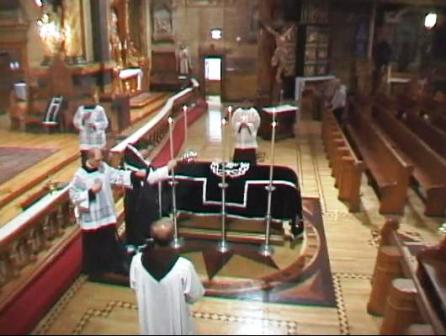
A choir director would find this section in case he has to learn how to sing for a Mass like this.
The baptism video starts with the blessing of water from the Roman Ritual.
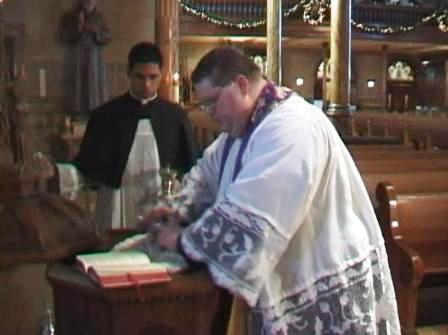
It shows how to get everything ready beforehand. (Don’t forget the bread and lemon!)
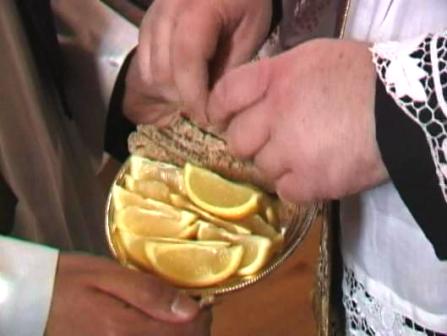
It makes good recommendations about more solemn baptisms.
It speaks of a deacon doing a baptism with the pastor’s permission. There is an instruction about sponsors.
There is cute and occasionally unhappy baby.
A Benediction service is filmed. There are text overs. You can see clearly what is done. Spectacular music. beautiful bells, by the way.
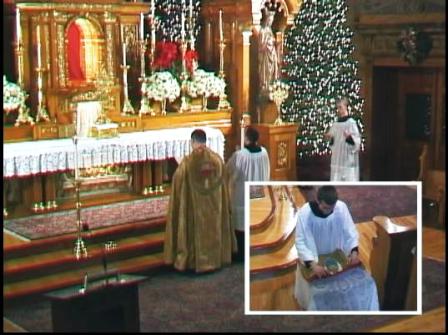
The section on Vespers could be very helpful for a priest and choir, with a group of lay people, trying to build up this beautiful example of our liturgical worship. Vespers is simply filmed.
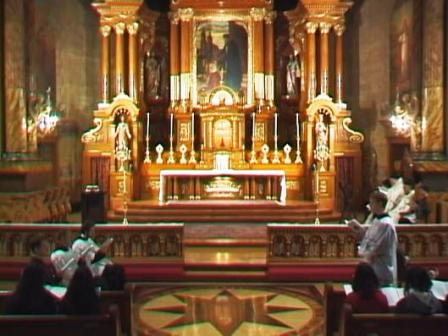
If you have your book to follow, the Liber Usualis, you can then watch the movements in the sanctuary to know what to do and when, make your notes and then recreate the service. What I would NOT recreate is the pace of their chanting of the psalms, etc. Far to slow. But that is a detail. The video is still useful
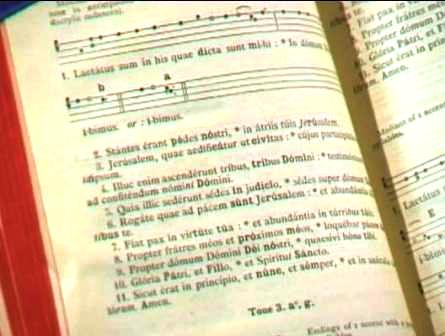


































“…this is the only sacrament the priest administers while sitting, because he is also in the role of a judge.”
Who has two thumbs and just learned something new?
ME!
What are the bread and lemon for? I do not see a mention of them in the Rite, either on sanctamissa.org or in my Angelus Press hand missal.
mrose, the lemons are probably to clean the oil from the priest’s fingers. Bishops do the same thing during chrism masses. I don’t know about the bread.
Ah, thank you Boniface!
does the bread have to be whole wheat? :o
The bread is also used to remove the oil. Acts kinda like a sponge, if I’m not wrong.
Wow what an awesome set! How I wish I had a zillion dollars to purchase these and send them around. I even know a priest who wouldn’t do the old baptism because he was so uncomfortable at making an untrained stab at it in front of everybody.
I attended a beautiful Missa Cantata this past Sunday. All through it, I wished it was being visually and audio recorded as it was done so beautifully and would have been a wonderful exposition of one method of presenting the Mass. We joined in the Entrance hymn, Asperges, a schola sang the Introit, the congregation joining as appropriate in the known sung parts of the Ordinary, and singing the appropriate responses. The music, with a mix of choir and male schola sang the Propers, Tract, and other Mass parts. We sang the Pater Noster [gasp, yes as you Fr Z have pointed out, there are at least 3 documents giving permission for this]. Not all Masses are silent, in spite of some traddy shushers who insist on such practices, and I wish dearly for a way to present the alternatives.
I am dumbfounded by the practicality of the lemons and the bread. Sure beats having to launder a towel drenched in oil, blessed or not blessed, although I would like to know how effective it is in actual use. Is that just used during the older liturgy, or do priests do it with the new liturgy too?
I can only look at the images in this posting and the YouTube video in the posting directly after it and want to sing “One of These Things Is Not Like The Other.”
Tina – we are blessed to be in the Arlington diocese, no doubt. I thank God several times a day for our Priests and can never pray for them enough. I heard one pastor announce that we have (I think proportionally) the most parishes offering the Extraordinary Form in the USA.
There is much variety, too — one could go to St Rita’s where the dialogue aspect is encouraged quite a lot in a low Mass, or to St Michael’s (my favorite) which is as solemn and as quiet as I’ve ever experienced. [BTW, St Rita’s pastor now offers his OF Mass on Sunday ad orientem and has his priests/deacon stand behind the altar rail for Holy Communion — the first time he did this, a few months back, about half the congregation elected to kneel and receive on the tongue. I’d say about 2/3 do so now, every Sunday!]
If I ever go to Chicago, however, I will be booking my hotel as close to Saint John Cantius as possible — they’re-so-awesome!!!
Hmmmm, interesting! I would love a good set explaining all the minute details of the sacraments and mass etc. Maybe these could be better presented, but this here is a good example of using media to teach people stuff! Much better than reading books, as you tend to better understand what you see, and even better what you see and read and do.
Bread and lemon?
The lemon cuts the oil, the bread soaks it up. The bread is then buried in the ground. Since chrism (and the other holy oils) are consecrated, it is not proper to merely throw a towel in the washing machine with them on it. Holy Oils, along with anything blessed/consecrated should never be thrown away or poured down the drain. If something like this needs to be discarded, burying it does so naturally and in a respectful manner. The same principle is employed with the sacrarium, it drains directly into the ground and not the sewer.
I’ve only seen it used in a Novus Ordo context in St. Louis and amongst very traditionally minded NO communities. It is very unfortunate, however, that this practice is not mandated as it was in pre-Vatican II times. It is not like Chrism is no longer holy, but I would think that the people who were in power after Vatican II like to think of such practices as superstitious-just like their Protestant and Jansenist predecessors.
Pingback: DVD sobre “Ritos Sagrados e Cerimónias” « Una Voce Portugal
Pingback: FRIDAY EVENING EXTRA | ThePulp.it
Pingback: Lemons and Salt and the Empty Chair « Aliens in This World